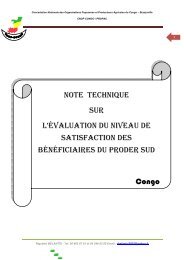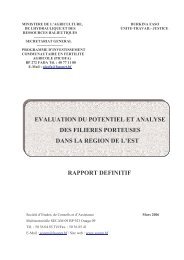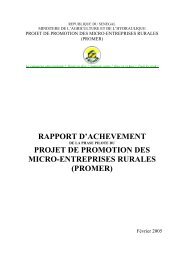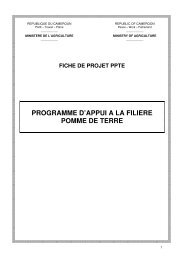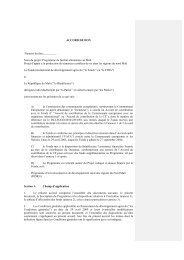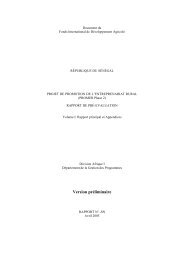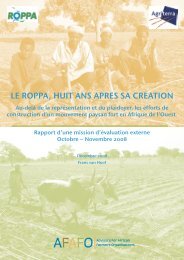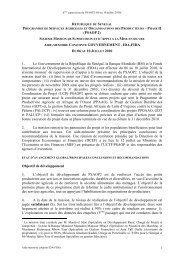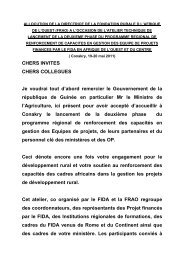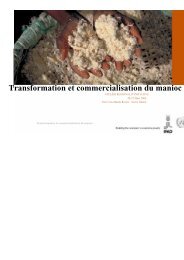Scaling Up the Fight Against Rural Poverty - FIDAfrique
Scaling Up the Fight Against Rural Poverty - FIDAfrique
Scaling Up the Fight Against Rural Poverty - FIDAfrique
Create successful ePaper yourself
Turn your PDF publications into a flip-book with our unique Google optimized e-Paper software.
Chapter 1<br />
Introduction: Setting <strong>the</strong> Stage<br />
IFAD recognizes <strong>the</strong> need for scaling up successful development interventions. For example, IFAD’s<br />
Strategic Framework for 2007-2010 states that “innovation without scaling-up is of little value” (IFAD<br />
2007a, p. 6), and IFAD’s Innovation Strategy declares that “effective scaling-up is a key measure of<br />
successful innovation” (IFAD 2007b, p. 8). These statements set <strong>the</strong> stage for <strong>the</strong> scaling up review of<br />
IFAD presented in this report. They place scaling up at <strong>the</strong> core of IFAD’s operational strategy. This<br />
review aims to assess whe<strong>the</strong>r and how <strong>the</strong>se strategic statements have been translated into operational<br />
practice and what steps IFAD can take to deliver fully on its scaling up mission. IFAD is exceptional<br />
among development assistance agencies for having made <strong>the</strong> scaling up of successful interventions a<br />
key institutional goal. IFAD can <strong>the</strong>refore serve as an example for o<strong>the</strong>r development partners.<br />
This chapter addresses four questions by way of introduction: Why scale up? Why scaling up for<br />
IFAD? Why a scaling up review for IFAD? How was this scaling up review carried out?<br />
A. Why scaling up?<br />
The international community has set ambitious Millennium Development Goals (MDGs) for<br />
sustainable global poverty reduction by 2015. But in mid-2010 it is clear that achieving <strong>the</strong>se targets<br />
will be difficult for most developing countries; many will not be able to do so, especially in Africa.<br />
(IDA 2010a) In <strong>the</strong> Paris Declaration on Aid Effectiveness international development (donor) partners<br />
and partner (recipient) countries agreed on ways to ensure that development assistance is put to good<br />
use in helping to achieve <strong>the</strong> MDGs. Interim reviews by OECD-DAC have shown progress, but here<br />
again much remains to be done. Over <strong>the</strong> first decade of <strong>the</strong> 2000s development assistance has<br />
increased substantially and <strong>the</strong> number of development partners has expanded dramatically, but <strong>the</strong><br />
ambitious goals for increased aid set at <strong>the</strong> Glenn Eagles G8 Summit are far from being met. 1<br />
It is in this context of worthy and ambitious development goals, so far not nearly met by <strong>the</strong><br />
international community, that we find <strong>the</strong> rationale for scaling up successful development<br />
interventions, as stated by Hartmann and Linn (2008, p. 2) in <strong>the</strong>ir review of <strong>the</strong> scaling up experience<br />
in development:<br />
“[T]he challenge is not just a matter of more, better coordinated and less volatile aid. A key<br />
constraint that needs to be overcome is that development interventions—projects, programs,<br />
policies—are all too often like small pebbles thrown into a big pond: <strong>the</strong>y are limited in scale,<br />
short-lived, and <strong>the</strong>refore without lasting impact. This may explain why so many studies have<br />
found that external aid has had only a weak or no development impact in <strong>the</strong> aggregate at <strong>the</strong><br />
global and at <strong>the</strong> country level, even though many individual interventions have been<br />
successful in terms of <strong>the</strong>ir project- or program-specific goals. In order to reduce poverty<br />
substantially, we have to follow <strong>the</strong> advice of James Wolfensohn and discover ‘how to move<br />
from our feel-good successes to large scale, how to scale up <strong>the</strong>se initiatives to a depth and<br />
breadth where we can really have an impact on poverty, where we can achieve <strong>the</strong> Millennium<br />
1 For relevant background on trends in development assistance see Kharas (2007), IDA (2010b).<br />
4



